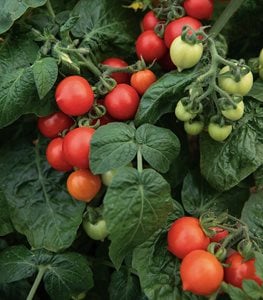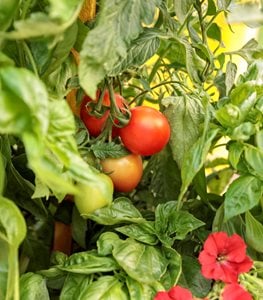Different Types of Tomato Plants
Learn how to choose the right tomato to grow in your gardenThere are hundreds of different tomato varieties to grow, with fruits ranging from bite-sized cherry tomatoes to robust beefsteak tomatoes weighing two pounds or more. Their culinary uses are nearly endless, from snacking, salads and sandwiches, to sauces and preserving. To determine which kinds of tomatoes are right for you, evaluate your growing space and how you’ll be using the tomatoes. Get started growing the best tomatoes on your block!
TYPES OF TOMATO PLANTS
Tomatoes come in different sizes, shapes, and water content, which can help determine what kind to grow and how to use them. Here are some of the most common types:
- Beefsteak tomato: Among the largest fruits, beefsteaks have a juicy, meaty texture and classic flavor. Round, slightly flattened fruits are superior slicers for sandwiches, salads, and caprese.
- Campari tomato: Also known as tomatoes on the vine. Golf-ball-sized fruits have low acidity, exceptionally sweet flavor, and juicy texture. Good for snacking, salads, salsa, roasting, and bruschetta.
- Pear tomato: Small pear-shaped fruits have a sweet mild flavor and juicy texture. Plants are heavy producers over a long time. Good for snacking, salads, and preserves.
- Plum tomato: Popular plum tomatoes are Roma and San Marzano. The water content is low and texture is firm, making these a good choice for tomato sauce, paste, roasting, drying, and canning. Fruits are mellow tasting, medium sized, and oval shaped.
- Salad tomato: Rounded fruits, 2-3 inches in diameter, are perfect for slicing on sandwiches or chopped in salads. Somewhat tart and juicy, these have a good balance of acid and sweet.
- Grape tomato: Similar to plum tomatoes but smaller, the oval-shaped fruits grow in clusters similar to cherry types but have a thicker, meatier texture, and milder flavor. Good for snacking, salads, kebabs, and roasting.
- Cherry tomato: Bite-sized rounded fruits that grow in clusters are juicy and sweet tasting. Good for snacking, salads, kebabs, roasting, and quick sauces.

Determinate, indeterminate, or semi-determinate?
All tomatoes are either determinate, indeterminate, or semi-determinate. It is important to keep these definitions in mind when choosing what tomatoes to grow—depending on your growing space and how you want to use them.
- Determinate: ("bush tomatoes")
- Plants grow 1-3 feet tall
- Ideal for patios, containers, and small space gardens.
- Produce one big crop and die off near the end of the growing season.
- Because fruits ripen all at once, good for larger quantity uses such as canning, sauces, and drying.
- On plant labels, these will be abbreviated as DET.
- Indeterminate: ("vining tomatoes")
- Plants grow up to 10 feet tall and need sturdy support.
- More suited to raised beds and larger vegetable plots.
- Continue to grow and produce fruit throughout the growing season.
- On plant labels, these will be abbreviated as IND or INDET.
- Semi-determinate:
- More compact than indeterminate plants
- Produce fruit throughout the growing season
Heirloom vs hybrid?
- Heirloom: Heirloom tomatoes have been around for hundreds of years. They tend to have the best flavor and come true from seed, which means that you will get the exact same variety from seed saved from the previous year. These can be determinate, indeterminate, or semi-determinate.
- Hybrid: Hybrid tomatoes are a cross between two varieties and bred for particular traits such as disease-resistance and cold hardiness. They can be somewhat less flavorful than heirlooms and will not come true from seed. These can be determinate, indeterminate, or semi-determinate.
How long do tomatoes take to grow?
Tomatoes can also be classified by how long it takes for the plant to grow and fruit to ripen.
- Early season: Varieties bred to grow and ripen quickly—in 65 days or less. These are a good choice for cooler climates and shorter growing seasons.
- Mid season: Maturity takes 70-80 days, with fruit production in mid-summer.
- Late season: These take the longest to mature, 80-100 days. Fruit tends to be bigger and better tasting, as they’ve had more time to mature on the vine.
When choosing a particular variety to plant, make sure the number of “days to maturity” is less than the number of days between time of planting and your average first frost date.
HOW TO CHOOSE THE RIGHT TOMATO PLANT
For edible plots and raised beds:
Plant either determinate or indeterminate types.
For containers:
Determinate types that stay smaller and need little or no support are best. Look for patio types that are especially bred for containers. These include Tempting Tomatoes® Goodhearted®, ‘Tiny Tim’, ‘Elfin’, and ‘Patio Princess’. (Read more on how to grow tomatoes in containers)
For hanging baskets and upside down planters:
Use determinate trailing types that have been proven to grow well in hanging baskets and small containers. These include ‘Tumbler’, ‘Maskotka’, ‘Red Robin’ and ‘Balconi Red’.
TOMATO VARIETIES
Tempting Tomatoes® Goodhearted® — Buy plants & seeds from Proven Winners
Type: Semi-determinate in northen climates, determinate in southern climates
Habit: Compact bushy habit
Height/Spread: 8-12 inches tall and 12-18 inches wide
Color: Red fruit
Days to maturity: 65-72 days from time of planting
This small plant is perfect for containers, balconies, patios, and small spaces. A good producer with cherry-sized heart-shaped fruits, juicy texture, and good sweet-to-acid balance. Heat and humidity tolerant, disease-resistant, and needs no staking or caging.
Tempting Tomatoes® ‘Garden Treasure’ — Buy plants & seeds from Proven Winners
Type: Indeterminate
Habit: Upright bushy habit
Height/Spread: 34-48 inches tall and 12-20 inches wide
Color: Red fruit
Days to maturity: 70-75 days from time of planting; 91-103 days from seed
This slicing type produces fruit all summer. Developed to have rich heirloom taste with modern disease-resistance. Produces medium-sized fruit with a mild balanced flavor, good in salads and sauces. Can be grown in containers or the landscape, and will need staking or caging.
Tempting Tomatoes® ‘Garden Gem' — Buy plants & seeds from Proven Winners
Type: Semi-determinate
Habit: Upright bushy habit
Height/Spread: 30-42 inches tall and 12-20 inches wide
Color: Red fruit
Days to maturity: 60-65 days from time of planting; 81-93 days from seed
The snack-sized fruit was developed to have rich heirloom taste with modern disease-resistance, short-season maturity, and high yields. Firm, juicy fruit has a smooth, well-balanced flavor and is good for snacking, salads, and roasting. Grow in a container, raised bed or vegetable plot; needs staking or caging.
‘San Marzano’
Type: Indeterminate
Habit: Upright vining habit
Height/Spread: 5-6 feet tall and 1 1/2 feet wide
Color: Red fruit
Days to maturity: 80 days from time of planting
This heirloom is a favorite of chefs and avid foodies, widely regarded as one of the best plum tomatoes for its superior well-balanced flavor and firm texture. Oval 4-inch long fruits are nearly seedless. Use for canning, sauces, and paste. The tall vining stature requires a large cage or trellis for support.
‘Big Boy’
Type: Indeterminate
Habit: Upright bushy habit
Height/Spread: 4-6 feet tall and 1-2 feet wide
Color: Red fruit
Days to maturity: 78 days from time of planting
This classic hybrid variety is one of the most popular beefsteak types, with large rich red fruits weighing 10-16 oz. Vigorous plants produce blemish-free, crack-resistant fruits. Peak yield is mid-season, with continuous fruiting into fall. Needs good support. Use for sandwiches, salads, and caprese or cooked as spaghetti sauce.
'Better Boy'
Type: Indeterminate
Habit: Upright vining habit
Height/Spread: 5-8 feet tall and 18 inches wide
Color: Red fruit
Days to maturity: 70-75 days from time of planting
An improved version of ‘Big Boy’ and a favorite beefsteak variety. This hybrid produces larger fruits with smooth skins weighing up to 1 lb. each. Highly adaptable, with abundant yields mid-summer to frost. Especially resistant to wilting diseases. Classic tomato flavor with a perfect balance of sweetness and acidity. Good slicers for salads, sandwiches, and caprese. Needs strong support.
'Celebrity'
Type: Determinate (sometimes considered semi-determinate)
Habit: Upright bushy habit
Height/Spread: 3-4 feet tall and 2-3 feet wide
Color: Red fruit
Days to maturity: 70 days from time of planting
An award-winning hybrid, versatile and low-maintenance with high yields, making it a good choice for beginning gardeners. Perfectly rounded crack-resistant fruits weigh 7-10 oz. Sometimes considered semi-determinate because fruit is produced from mid-summer until frost. A great all-purpose tomato that’s ideal for slicing, salsa, canning, and sauces. Quick maturity rate makes this a good choice for short-season climates.
'Cherokee Purple'
Type: Indeterminate
Habit: Upright bushy habit
Height/Spread: 4-6 feet tall and 1 1/2 feet wide
Color: Fruit has pink-red skin, deep red flesh
Days to maturity: 80-90 days from time of planting
Consistently ranked as one of the best-tasting heirloom beefsteak types. Rich sweet flavor makes this the ultimate BLT slicer. Hefty fruits 5 inches wide weigh 8-12 oz and are distinctly colored. Because of the delicate meaty texture and high water content, fruits should be used quickly. Needs strong support.
'Early Girl'
Type: Indeterminate
Habit: Vining or bushy habit
Height/Spread: Vining types 6-8 feet tall and 4 feet wide; bush types 3 feet tall and wide
Color: Red fruit
Days to maturity: 59 days from time of planting
One of the earliest fruiting tomatoes, cold-tolerant, and good for short-season climates. Vigorous plants bear clusters of 5 oz. meaty fruits early in the season, continuing to produce longer than most other varieties. The medium-sized flavorful fruits are good for slicing and cooking. There are both vining and bush forms, with bush types suited to containers and small spaces.
'Sun Gold'
Type: Indeterminate
Habit: Upright vining habit
Height/Spread: 4-6 feet tall and 1 1/2 feet wide
Color: Orange-yellow fruit
Days to maturity: 65 days from time of planting
One of the most popular cherry types, especially vigorous and prolific. Clusters of exceptionally sweet yellow-orange fruits are produced all summer long. Flavor develops before being fully ripened, allowing for longer harvest time. Best when eaten right off the vine; use for snacking, salads, vegetable trays, tomato pie, canning, and quick roasting. Needs strong support. Good disease-resistance to fusarium wilt and tobacco mosaic virus.
QUICK GUIDE TO USING TOMATOES
Tomatoes are packed with nutrition while low in calories. They are high in vitamin C, potassium, beta carotene, and lycopene, an antioxidant which is thought to reduce the risk of heart disease and cancer. The uses for tomatoes are nearly endless.
Fresh tomatoes are good for snacking, sandwiches, salads, dips, caprese, pizza toppings, salsa, and pico de gallo. Heirlooms and slicers are best for sandwiches, bruschetta, and caprese, while cherry and grape tomatoes are good for snacking and salads. Fresh tomatoes are best stored on a countertop or windowsill. Refrigeration can result in loss of flavor.
Tomato pulp can be used to make marinara sauce, pasta sauce, ketchup, soup, pizza sauce, juice, or paste. Press through a food mill or fine strainer to remove seeds, core and skin. This is a good way to use up excess tomatoes. Tomato pulp freezes well for later use.
Whole or chopped tomatoes can be preserved, canned, roasted, grilled, dried, or frozen. Sun-dried tomatoes are a staple of Italian cuisine. Plum and grape types with lower water content and firmer flesh tend to work best.
Green tomatoes can be fried (a Southern favorite) or made into jam, chutney, salsa, or relish.
Cooked or fresh tomatoes are a versatile ingredient for stuffed tomatoes, stew, tomato pie, chili, tarts, and casseroles.
Find recipes here: Foodscaping with Flair
MORE ON GROWING TOMATOES
RELATED:
Garden Edibles: Success Secrets
Arbors, Trellises, and the Edible Garden
How to Grow Strawberry Plants



















